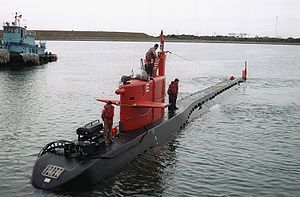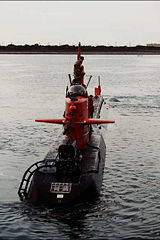- American submarine NR-1
-

Deep Submergence Craft NR-1.Career (United States) 
Name: NR-1 Builder: General Dynamics Electric Boat Laid down: 10 June 1967 Launched: January 25, 1969 In service: October 27, 1969 Out of service: November 21, 2008 General characteristics Displacement: 400 tons Length: 45 meters (150 feet) overall, 29.3 meters (96 feet 1 inch) pressure hull Beam: 3.8 meters (12 feet 6 inches) 4.8 meters (15 feet 10 inches) at stern stabilizers. Draft: 4.6 meters (15 feet 1 inch)
BOX keel depth (below base-line): 1.2 meters (4 feet)Propulsion: one nuclear reactor, one turbo-alternator, two external motors, two propellers, four ducted thrusters (mounted diagonally in two "x-configured" pairs) Speed: 4.5 knots surfaced, 3.5 knots submerged Endurance: 210 man-days nominal
16 Days for a 13 person crew
330 man-days maximum
25 Days for a 13 person crewComplement: three officers, eight crewmen, two scientists Notes: Motto: The World's Finest Deep Submersible The Deep Submergence Vessel NR-1 was a unique United States Navy nuclear-powered ocean engineering and research submarine. It was built by the Electric Boat Division of General Dynamics at Groton, Connecticut. It was launched on January 25, 1969, completed its initial sea trials August 19, 1969, and is home-ported at Naval Submarine Base New London. Casually known as "Nerwin", NR-1 was never officially named or commissioned. The U.S. Navy is allocated a specific number of warships by the U.S. Congress. Admiral Hyman Rickover not only avoided using one of those allocations, but he also wanted to avoid the oversight that a warship receives from various bureaus.
Contents
History
NR-1's missions included search, object recovery, geological survey, oceanographic research, and installation and maintenance of underwater equipment. NR-1's unique capability to remain at one site and completely map or search an area with a high degree of accuracy was a valuable asset on several occasions.
Following the loss of the Space Shuttle Challenger in 1986, NR-1 was used to search for, identify, and recover critical parts of the Challenger craft. Because it could remain on the sea floor without resurfacing frequently, NR-1 was a major tool for searching deep waters. NR-1 remained submerged and on station even when heavy weather and rough seas hit the area and forced all other search and recovery ships into port.
In 1995, Dr. Robert Ballard used the NR-1 and its support ship, the MV Carolyn Chouest, to explore the wreck of the HMHS Britannic, the sister ship of the RMS Titanic, which struck a mine and sank off the coast of Greece while serving as a hospital ship during World War I.
On February 25, 2007, NR-1, towed by Carolyn Chouest, arrived in Galveston, Texas, in preparation for an expedition to survey the Flower Garden Banks National Marine Sanctuary and other sites in the Gulf of Mexico.[1]
The NR-1 was deactivated on November 21, 2008 at the U.S. Navy submarine base at Groton, Connecticut, then sent to Puget Sound Naval Shipyard to be scrapped.[2]
Capabilities
The NR-1 performed underwater search and recovery, oceanographic research missions and installation and maintenance of underwater equipment to a depth of almost half a nautical mile. Its features included extending bottoming wheels, three viewing ports, exterior lighting, television and still cameras for color photographic studies, an object recovery claw, a manipulator that could be fitted with various gripping and cutting tools and a work basket that could be used in conjunction with the manipulator to deposit or recover items in the sea. Surface vision was provided by a television periscope permanently installed on a fixed mast its her sail area.
NR-1 had sophisticated electronics, computers and sonar systems that aided in navigation, communications, and object location and identification. It could maneuver or hold a steady position on or close to the seabed or underwater ridges, detect and identify objects at a considerable distance, and lift objects off the ocean floor.
NR-1 was equipped with two electric-motor driven propellers and its maneuverability was enhanced by four ducted thrusters, two in the front and two in the rear. The vehicle had diving planes mounted on the sail, and a conventional rudder.
NR-1 could travel submerged at approximately four knots for long periods, limited only by consumable supplies — primarily food. It could study and map the ocean bottom, including temperature, currents, and other information for military, commercial and scientific uses. Its nuclear propulsion provided independence from surface support ships and essentially unlimited endurance.
NR-1 was generally towed to and from remote mission locations by an accompanying surface tender, which was also capable of conducting research in conjunction with the submarine. NR-1's last mother ship was the MV Carolyn Chouest, which provided towing, communications, berthing and direct mission support for all NR-1 operations. An extremely versatile platform, it was an indispensable member of the NR-1 deep submergence team. The NR-1 command was manned with thirty-five Navy personnel and ten civilian contractor personnel. NR-1 carried as many as thirteen persons (crew and specialists) at one time, including three of the four assigned officers. (The Operations Officer rode on the MV Carolyn Chouest). All personnel that crewed NR-1 were nuclear-trained and specifically screened and interviewed by the Director, Navy Nuclear Propulsion Program, Admiral Kirkland H. Donald.
References
- ^ PO3 Brandon Shelander (2007-03-01). "NR-1 in Texas For Gulf Exploration". Navy News. Military.com. http://www.military.com/features/0,15240,126997,00.html. Retrieved 2007-03-01.
- ^ Deep-diving NR-1 wraps up its 40-year career
Further reading
- Lee Vyborny and Don Davis (2003). Dark Waters: An Insider's Account of the NR-1, The Cold War's Undercover Nuclear Sub. New American Library. ISBN 0451207777.
External links
Categories:- Submarines of the United States Navy
- Cold War submarines of the United States
- United States Navy experimental nuclear submarines
- United States Navy nuclear ships
- Deep diving submarines
- 1969 ships
- Unique submarines
Wikimedia Foundation. 2010.


